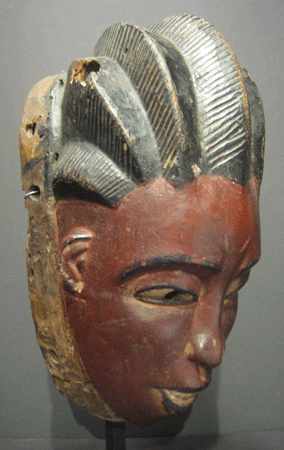Guro Mask, 1850 CE - 1910 CE
Wood
6.75 x 11.75
LSO.240
With a population of 200,000 the Guro live west of the Baule people on the Côte d’Ivoire, in a heterogeneous area of free-filled savannas and dense tropical forest. Originally they...
With a population of 200,000 the Guro live west of the Baule people on the Côte d’Ivoire, in a heterogeneous area of free-filled savannas and dense tropical forest. Originally they were called Kweni, but they were violently colonized between the years 1906 and 1912 and the dominant Baule people of the region subsequently named them the Guro tribe. The Guro farm predominantly cotton, rice, coffee and cocoa – the men clear the field and the women plant. The daily life of the Guro is dominated by secret societies and by a belief in protective spirits, to whom the Guro used to build shrines and create figures. The most significant in this respect is the Je society, which is responsible for social, political, and juridical questions, decisions of peace and war, policing tasks, and the detection of destructive forces, as well as appearing at funerals of its members. The Guro people are governed and regulated by a council of elders, each of them representing one of the main families.
The art of the Guro is distinguished by extreme refinement. Notable features on masks are almond shaped eyes, rounded foreheads, finely sculptured nose and mouth with small but sprouting lips. The face of the human mask is usually longish while the forehead and bridge of the nose form an elegant S-shaped profile. The hairdo is often delicately carved in elaborate geometrical patterns, mostly in five parts. Guro masks have small mouths and sharpened teeth. Another characteristic of many Guro masks is the broad, wooden collar that serves as a fixture for a raffia cloak worn by the dancer. The masks are normally colorful as well as black and brown and coated with natural dyes. Guro mask represents the spirit of Gu, the wife of Zamble a supernatural being. Gu is often depicted as elegant, graceful, serene and beautiful. Sacred Guro masks, delicately crafted and colorful are used and honored during sacrificial gatherings, funerals, and celebrations. They honor protective spirits called "Zuzu" which are housed in shrines.
The art of the Guro is distinguished by extreme refinement. Notable features on masks are almond shaped eyes, rounded foreheads, finely sculptured nose and mouth with small but sprouting lips. The face of the human mask is usually longish while the forehead and bridge of the nose form an elegant S-shaped profile. The hairdo is often delicately carved in elaborate geometrical patterns, mostly in five parts. Guro masks have small mouths and sharpened teeth. Another characteristic of many Guro masks is the broad, wooden collar that serves as a fixture for a raffia cloak worn by the dancer. The masks are normally colorful as well as black and brown and coated with natural dyes. Guro mask represents the spirit of Gu, the wife of Zamble a supernatural being. Gu is often depicted as elegant, graceful, serene and beautiful. Sacred Guro masks, delicately crafted and colorful are used and honored during sacrificial gatherings, funerals, and celebrations. They honor protective spirits called "Zuzu" which are housed in shrines.
